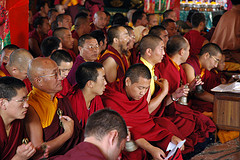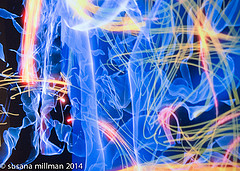
Do you struggle with stress? Are you uncertain of how to deal with it? Then you might consider developing your capacity for the relaxation response. Allow me to explain.
In 1971, a Harvard trained medical doctor published a landmark book. It was called The Relaxation Response. It was a revolutionary moment that’s easy to see in hindsight. But at the time, it was like a tiny pebble rolling down the mountain which eventually triggered a land-slide.
That doctor’s name was Herbert Benson. When you see the proliferating media coverage on mindfulness and meditation, we have him to thank. When you hear about all the new studies that scientifically prove the benefits of meditation, he’s one of the pioneers who made that possible. And next time your doctor recommends starting a meditation practice because you have symptoms of stress, Herbert Benson deserves a lot of the credit.
 Against the norms of the establishment, Dr. Herbert Benson did extensive studies on the effects of meditation in the 60’s and early 70’s. He spent time examining the brains of buddhist monks and he examined the effects of meditation on practitioners of the popular mantra-based Transcendental Meditation movement started by Maharishi Mahesh Yogi.
Against the norms of the establishment, Dr. Herbert Benson did extensive studies on the effects of meditation in the 60’s and early 70’s. He spent time examining the brains of buddhist monks and he examined the effects of meditation on practitioners of the popular mantra-based Transcendental Meditation movement started by Maharishi Mahesh Yogi.
What he found was amazing, and he distilled the results in this groundbreaking book, The Relaxation Response. Dr. Benson published his first scientific article on the topic in the American Journal of Physiology in 1971. The title of the paper was, “A wakeful hypometabolic physiologic state.” In other words, meditation.
What Is The Relaxation Response?
So what is the relaxation response exactly? To quote Dr. Benson:
The relaxation response is a physical state of deep rest that changes the physical and emotional responses to stress… and the opposite of the fight or flight response.” It is “an opposite, involuntary response that causes a reduction in the activity of the sympathetic nervous system.
In a pain management guide produced by the University of Michigan, they describe the Relaxation Response this way:
The Relaxation Response is your personal ability to make your body release chemicals and brain signals that make your muscles and organs slow down and increases blood flow to the brain. Drugs can do some of this for you, however they often have unwanted side effects. You can get your body to relax just as well without drugs while remaining conscious and aware at the same time. To be physically relaxed and mentally alert is the goal of the relaxation response.
Since 1971, there have been numerous studies on the relaxation response which have highlighted the following short-term benefits to the nervous system:
- lower blood pressure
- improved blood circulation
- lower heart rate
- less perspiration
- slower respiratory rate
- less anxiety
- lower blood cortisol levels
- more feelings of well-being
- less stress
- deeper relaxation
Meditation And The Relaxation Response
 Dr. Benson’s work was the foundation of a now-burgeoning field of study. Indeed, Dr. Benson is a founding member of the Benson-Henry Institute for Mind Body Medicine, affiliated with Harvard Medical School.
Dr. Benson’s work was the foundation of a now-burgeoning field of study. Indeed, Dr. Benson is a founding member of the Benson-Henry Institute for Mind Body Medicine, affiliated with Harvard Medical School.
Both within and beyond Harvard, extensive research now explores the neurological benefits of meditation. Preliminary results show that meditation–and the relaxation response–can increase blood flow to different regions of the brain and expand grey matter in the areas of the brain associated with memory and emotion.
Indeed, research shows that meditation is one of the most effective ways to stimulate your relaxation response. When your mind is focused, and you resist the temptation to let it wander, that’s the essence of meditation training. And consistent focused training in meditation will help you achieve a state of deep health and wellness.
Are there other ways to experience the benefits of the relaxation response besides meditation? According a Boston Globe article:
Monks are considered the superstars of meditation, but Benson and others say benefits can come from a spectrum of repetitive, mind-clearing practices that elicit the so-called relaxation response — from swaying in prayer to saying the rosary to knitting. Under that broad definition, about one-half of Americans perform some sort of meditation, mainly prayer, Benson said.
I think the most important thing you need to know about the relaxation response is this. It’s the most powerful and effective countermeasure to chronic stress. Recent statistics claim that more than 50% of all medical visits are stress related. In the UK alone, stress related illness costs businesses $4.5 billion annually.
So stress is a huge issue in our society. One of the most effective ways to manage stress and reverse its damaging effects is through regular meditation practice.
A 6-Step Guide To Your Relaxation Response
To practice the relaxation response yourself, try this step-by-step guided exercise from Dr. Benson’s book pages 162-163.
1. Sit quietly in a comfortable position.
2. Close your eyes.
3. Deeply relax all your muscles, beginning at your feet and progressing up to your face. Keep them relaxed.
4. Breathe through your nose. Become aware of your breathing. As you breathe out, say the word, “one”, silently to yourself. For example, breathe in … out, “one”,- in .. out, “one”, etc. Breathe easily and naturally.
5. Continue for 10 to 20 minutes. You may open your eyes to check the time, but do not use an alarm. When you finish, sit quietly for several minutes, at first with your eyes closed and later with your eyes opened. Do not stand up for a few minutes.
6. Do not worry about whether you are successful in achieving a deep level of relaxation. Maintain a passive attitude and permit relaxation to occur at its own pace. When distracting thoughts occur, try to ignore them by not dwelling upon them and return to repeating “one.”
With practice, the response should come with little effort. Practice the technique once or twice daily, but not within two hours after any meal, since the digestive processes seem to interfere with the elicitation of the Relaxation Response.
Learn how to trigger your relaxation response through our free How To Meditate mini course here.
(Photos via Flikr Creative Commons: James Wheeler; Susana Millman; wonderlane)


